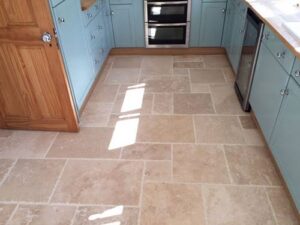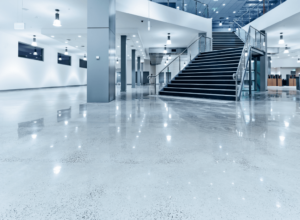Polished Concrete; Maryland
Flooring is an important decision for any homeowner. Not only does it have a significant impact on the aesthetic appeal of your home, but it also plays a vital role in terms of functionality and durability. Among numerous flooring options available, polished concrete flooring is rapidly gaining popularity, owing to its durability, low maintenance, and stylish looks. This article will shed light on the costs of polished concrete flooring and the upgraded option of heated concrete flooring. Moreover, we will delve into how heated floors function and explore the myriad benefits of radiant heat flooring solutions.
Enhanced Attributes of Concrete Flooring
One of the captivating aspects of concrete flooring is its versatility in customization. Homeowners can choose to personalize their concrete floors through a variety of methods including stains, etching, dyes, and degrees of finish. Beyond its aesthetic appeal, concrete flooring offers numerous practical benefits. This eco-friendly flooring option circumvents the need for hazardous chemical sealants which are often required by other flooring materials. Besides, concrete floors are renowned for their durability, low maintenance, and easy cleaning attributes. An additional advantage of polished concrete flooring is its reflective surface which can efficiently brighten up any room. Even with all these benefits, the greatest allure of concrete flooring might be the exceptional value it offers for its price.
 Evaluating the Cost of Polished Concrete (Per Square Foot)
Evaluating the Cost of Polished Concrete (Per Square Foot)
Armed with the knowledge of the many benefits of concrete flooring, you may now be interested in understanding the cost implications of installing such a floor. The cost of a polished concrete floor is largely determined by three factors – the desired level of shine, the size of the floor, and the complexity of the project. A basic concrete floor with moderate shine and a stain can cost approximately $3-$5 per square foot.
However, more sophisticated flooring projects with intricate etched designs, multicolored dyes, and high polish may cost between $8-$12 per square foot or more as the complexity escalates. To put this into perspective, other flooring options such as bamboo, vinyl, tile, or hardwood floors can cost anywhere between $1.50 to $24 per square foot. However, when factoring in durability, concrete floors outperform many other materials, thus the choice of concrete can be a wise long-term investment.
Estimating the Cost of Heated Concrete Floors (Per Square Foot)
For those who appreciate the robustness of concrete floors but are wary of the coldness, it may bring during winter months, radiant heated concrete floors offer a viable solution. These floors are typically categorized into two types – hydronic (water-based) radiant heat and electric. Hydronic heated floors can cost around $6-$20 per square foot, excluding the required boiler or additional water heater, while electric heated floors can cost between $8-$15 per square foot. Hydronic floors function by circulating warm water through a series of pipes, whereas electric-heated floors work by utilizing thin, heated wires.
The Inner Workings of Heated Floors
Traditional heating systems such as heated baseboards, standing radiators, or the circulation of warm air through a venting system differ significantly from radiant heating systems. Instead of distributing heat via these conventional methods, radiant heating emits heat from the floor upwards, warming everything it encounters including furniture, people, and walls. As heat rises, it sends thermal energy through the air in the form of electromagnetic infrared waves, releasing warmth when it hits an object, be it a sofa or a bed.
With advancements in technology, contemporary contractors are equipped to install a radiant heating system that warms objects directly instead of heating the air around them. This is achieved through the use of heated water, electric wires, solar or geothermal energy, or even propane. In essence, the principle is similar to how a stove burner heats a pot of water – a slow and controlled increase in temperature. An experienced contractor will take into account various factors such as the direction your house faces to determine the number of radiant heating elements needed to be installed in each room of your house or building.
 What Exactly Is Radiant Heat?
What Exactly Is Radiant Heat?
Radiant heat works on the principle of electromagnetic infrared waves that travel through the air until they hit an object or a person, at which point they release their heat. This concept differs from traditional heating methods that focus on heating the air within a room. The radiant heat method is often more energy-efficient, achieving a deeper level of warmth by heating the house from the ground up. A simple way to understand the concept of radiant heat is by considering the warmth you feel when sitting around a campfire.
Unveiling the Benefits of Heated Concrete Flooring If you’re considering radiant heating systems but unsure about heated concrete flooring, here are some compelling reasons why you might want to install them:
- Economical Over Time: Though it might appear as a significant upfront investment, installing a radiant heat system in your floors can prove to be cost-saving in the long run. Traditional heating methods can cost approximately $20 every 24 hours, while a radiant heat system may cost just $3 for the same duration. This could translate into significant savings on your future utility bills. Moreover, hydronic systems can be especially cost-effective as water can hold over 3,000 times the amount of heat that air can. Consequently, you can lower your thermostat settings on colder days without experiencing discomfort.
- Added Value: Despite the initial cost of installation, a well-installed radiant heating system can last up to 45 years. These systems require up to 50% less maintenance and running costs and can significantly add to the value of your house if you plan to sell it in the future.
- Family Friendly: If you’re concerned about elders getting chilly, toddlers hurting themselves on the radiator, or allergens circulating in the air due to centralized heating, heated concrete floors offer a safe solution. They don’t kick up allergens like dander or dust and also do away with the hazards of floor vents or radiators, ensuring a safe environment for children and pets.
- Low Maintenance: Even the most demanding type of radiant heating system, hydroponic, only requires an annual inspection, bearing lubrication, and cleaning.
- Enhanced Comfort: Radiant heating systems provide a unique level of comfort that’s akin to walking on warm floors during a cold winter day. As they warm the very structure of the house and not just the air within, they create a cozy atmosphere at lower thermostat settings than centralized air or radiators.
With a plethora of benefits, radiant heating systems often justify their initial installation cost. Starting from as low as $6 per square foot, investing in a hydronic system for your polished concrete floors could add warmth, value, and comfort to your home during the colder months. Moreover, these systems can also be adapted for cooling during the warmer seasons.
To delve deeper into the benefits of concrete flooring or to obtain a quote for your project, feel free to get in touch with Concrete, Etc. Discover how concrete flooring can add value and style to your home while also offering unique heating and cooling solutions.


 Evaluating the Cost of Polished Concrete (Per Square Foot)
Evaluating the Cost of Polished Concrete (Per Square Foot) What Exactly Is Radiant Heat?
What Exactly Is Radiant Heat?